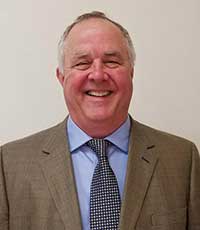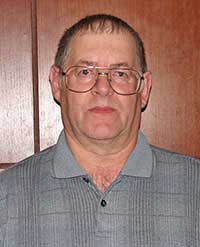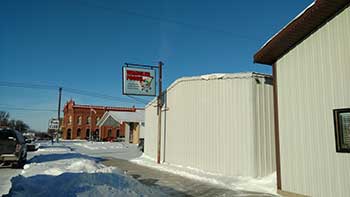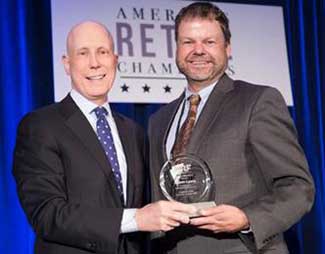Last updated on February 3rd, 2017 at 04:04 pm
by Terrie Ellerbee/editor-Midwest
North Dakota Grocers Association has a new president with deep roots
John “Jiggs” Dyste began his role as president of the North Dakota Grocers Association (NDGA) on Jan. 1. But his experience with the organization goes back many years. He served on its board of directors for more than 15 years.
He follows Roger Larson, who only was able to serve in the role for several months after longtime president Tom Woodmansee, who helmed the association for more than 31 years, retired in April 2016.

Dyste’s experience as a grocer goes back decades. He was the fourth generation to run the family’s grocery store at Main Street and Antelope Avenue in Forman. He had owned Dyste’s Food Pride since his father retired in 1979. The Forman store was known for customer service. Employees always carried groceries out to shoppers’ vehicles. On Fridays, Dyste’s would deliver groceries to approximately 10 to 15 households, especially in the wintertime. Customers repaid the store with their loyalty, despite there being two other stores where they could shop.
The family business was established back in 1885, making it one of the oldest businesses in North Dakota, which wasn’t even a state then.
Dyste also previously owned stores in Milnor, Hankinson and Lidgerwood. The beloved Forman store, as well as locations in Milnor and Lidgerwood were sold in 2014. In March 2016, the Dyste’s Food Pride in Hankinson was sold.
“My two daughters were the last in succession and neither one of them had any interest, so it came to an end,” Dyste told The Shelby Report. He joked that nearly 130 years is “a long time to sell prunes.”
Dyste will rely on his background and knowledge as he tackles issues important to grocers in North Dakota. Dyste speaks of the state as it if is one large community.
“North Dakota is a very rural state, so we know people from one end to the other,” he said. “There’s only 600-and-some-thousand of us, so we know people from all over. I think I have a feeling for where they’re at for the most part.”
When he talked with The Shelby Report, Dyste had spent the day in Bismarck as NDGA president, sitting in on committee meetings and getting his feet wet.
North Dakota’s economy in recent years was the stuff of legend, running high on shale oil drawn from its Bakken formation. The oil boom peaked in 2012, and as energy prices plummeted, growth slowed. Taxes paid into the state’s coffers slowed as well.
“But in their wisdom, the legislature through the years has put away excess money they got in funds—especially from the oil industry—so we have a large reserve,” Dyste said. “Our everyday income is down, and they’re using the reserve funds to soften some of the blows. There will be cuts, but the governor and the legislature also have pledged not to raise taxes. So they’re going to balance the budget, use some reserves, but they’re also going to cut government spending.”
The state has a new governor leading the charge who comes with a compelling background. Republican Douglas J. Burgum was president of a software company in the 1980s that he later sold to Microsoft in 2001 for more than $1 billion. He has no political experience.
“He’s got a great background in technology. He has a belief that government can be streamlined and you don’t have to ‘do it the way you’ve always done it.’ I think people are excited,” Dyste said. “It’s a pretty conservative state, but by the same token, there’s people that don’t like change. But he’s going to, I think, try to push the state into maybe a different way of doing things, and he thinks that they can save money in the process.”
As consumers have sought to save money on groceries, they have turned to retailers like Amazon.com and Walmart. With his background as an independent grocer, Dyste sees Amazon and its ilk as a real threat to small grocers.
“I know of some grandmas that are using Amazon to get product delivered to them. It’s amazing,” he said. “We don’t exactly know what Amazon is going to do or how we’re going to deal with it.”
Keeping rural grocers in business is a mounting concern as more of them close their doors. It seems only then does the community come around. He suggested that small, rural grocers make grocery shopping as convenient as possible for their local shoppers. That may include delivery or in-store pickup.
Saving the rural grocer
“When I talk about rural, we’re talking about communities of 400, 500 people, and (local customers) are struggling to hold onto their grocery stores so they don’t have to drive 50 miles to get groceries,” Dyste said. “As these smaller towns lose their grocery store, people have to go farther, and the communities are older, so the older people are now at a disadvantage even more so.”
Lori Capouch is the rural development director at the North Dakota Association of Rural Electric Cooperatives (NDAREC) in Mandan. A volunteer group that includes NDAREC, grocers, the North Dakota State University Center for Community Vitality and several other organizations have joined together for the North Dakota Rural Grocer Initiative. Capouch’s involvement in the program began about four years ago.
“We do rural development work here. We started getting a bunch of phone calls about grocery operators who were looking for grant money to cover shortages in operations costs,” she said. “We get calls like that once in a while, but when you get several of them from the same industry, you just take a moment and say, ‘wait a second. Something is happening here.’”
The cooperative hadn’t worked with grocery stores before, but after some Googling, it became clear what a pressing issue it was. NDAREC used a grocer survey developed by Kansas State University’s Rural Grocery Initiative to get started. The feedback from the survey proved interesting. Capouch said there only are about 120 rural grocery stores in the state, and one takeaway was that some believed joining the North Dakota Grocers Association was too expensive for them. (According to the NDGA website, a store with gross volume of $250,000 or less would pay $125 in dues per year.)
Dyste knows what these grocers are saying, and it isn’t just the expense. It also is the cost of participation.
“A lot of them are probably run by one or two, maybe three people, so if one of them leaves to go to a conference, that puts a strain on the whole operation,” he said.
Capouch said the consequences of not belonging to the NDGA are a “lack of education and information because they didn’t belong to the association that could keep them up to date on regulations and changing trends. They had no connection.”
The survey also asked the grocers about their suppliers.
“On a whim we said, ‘let’s just map that and see what it looks like,’” she said. “So we mapped a few of those, and what we discovered is that we do have declining populations, and volumes are a problem. We have a level of suppliers that have a minimum purchasing requirement, which is completely understandable, but when you can no longer achieve that, you get dropped and then you go to the next supplier, and then the next one.
“What it has created is this crisscrossing of suppliers across our state,” she added. “We have more trucks driving the same roads than before. They’re going longer distances with smaller stops, and it’s not good for the suppliers and it’s not good for our stores. It’s increasing the prices and the cost of doing business, so we’re trying to address that.”
Consideration has been given to private-public partnerships and cross-docking. For example, the state’s Department of Health called NDAREC to say it had an excess warehouse capacity, truck drivers and an online ordering system. Maybe they could get together.
“We’re not trying to replace the suppliers,” Capouch said. “We’re trying to find more regional drops maybe, and in a location that’s maybe publicly supported, then do that cross-docking and get that food that last distance. I think we can get greater variety, a lower cost and eliminate some of those food deserts.”

Fred Wangler has a store about 20 miles west of Fargo. He is one of several grocers serving on the North Dakota Rural Grocery Initiative. He told The Shelby Report that the biggest challenge rural grocers face is “getting the community to support the local grocery stores.
“I guess they don’t think they are real important until they’re gone, and then they notice that they really should have supported them more, even if the prices are a little bit higher than what they can pay in bigger cities,” Wangler said.
Wangler had six stores at one time. One of them was sold to the community, and the others were sold to local operators. He said local economic development groups helped get them reopened.
“One of the grocery stores I used to have was closed for seven years. I reopened it for them, and it’s still up and running now,” Wangler said. “That’s what I was doing for four or five years. I was reopening grocery stores that had closed or were in the process of closing.”
Wangler said another challenge is dating on products, some of which grocers are required to stock in certain amounts.

“People get upset if they find something that’s passed the ‘best by’ use date,” he said. “They think it’s a drop-dead date, which it isn’t. But that makes it tougher for the local stores to try and keep a good selection. The reason it goes outdated is because they’re not utilizing the store enough to buy it before it goes outdated.”
So, what does Wangler believe has helped those reopened stores stay in business? The very idea that they could close.
“They know if they’re not going to use them, they’re going to lose them,” he said. “So there’s more community support that way.”
•••
South Dakota retailers have an award-winning association representing them
Shawn Lyons was sitting on a plane in Denver last May when he got the call.
Lyons, who is executive director of the South Dakota Retailers Association (SDRA), was to be the recipient of the J. Thomas Weyant Award.
Given by the National Retail Federation (NRF), the award was established in 1995 to acknowledge people who have committed their professional careers to state retail associations. It is awarded only to those the NRF considers “the very best and most influential” state retail executives.

Lyons’ family was with him the very next night in Washington, D.C., viewing a video presentation featuring South Dakota Gov. Dennis Daugaard; U.S. Sens. Mike Rounds and John Thune; U.S. Rep. Kristi Noem; and Corey Brown, majority leader of the South Dakota senate.
They all spoke of Lyons’ hard work, courage, passion and strong family values.
Gov. Daugaard said the SDRA “probably is the most effective statewide business organization.”
“He doesn’t lack bravery,” said former SDGA board president Dan Tribby. “When there are things that it would be really easy to shy away from, he’s on the front lines saying ‘yes, our dog needs to be in this (fight).’ Because of that, I think the association just keeps getting stronger and stronger.”
But Lyons quickly deflects attention to the honor bestowed upon the organization’s incoming president, Gary Cammack, owner of Cammack Ranch Supply in the unincorporated community of Union Center. Cammack not only was honored as one of “America’s Retail Champions” by the NRF, but also was named the 2016 Champion of the Year. Retail champions are Main Street business owners who are strong industry advocates at all levels of government.
Cammack also is a South Dakota state senator and served as president pro-tempore for the legislative body. Cammack, whose store is in a community with a population of about 400 people, also is the incoming SDRA board president.
“For South Dakota and one association to receive those two honors was really, really amazing,” Lyons said. He describes the SDRA as a “hybrid organization” with a “wide swath” of members, joking that, “if you have a bubble gum machine you can be a member of the retail association.”
The SDRA has approximately 4,000 members and serves businesses from grocery to hardware stores to restaurants and beyond.
“I think in a state our size, all of those businesses coming together for one unified purpose—having a unified voice before the legislature—has worked very well for us since 1897,” Lyons said.
Fourth-generation grocer RF Buche, president of GF Buche Co., has served on the SDRA’s board of directors since 2012. Buche now is moving to the SDRA’s executive board and eventually will become its president. Buche also serves on the National Grocers Association board.
A busy legislative session
SDRA’s annual meeting was held Jan. 9 in the state capital of Pierre. Members who attended heard legislative previews from Gov. Daugaard, new Speaker of the House Mark Mickelson and Senate Minority Leader Billie Sutton. They also heard from Marcia Hultman, the state’s labor secretary.
The state limits its senators and representatives to four terms, or eight years, and this year about one-third of the legislature are new members.
“Obviously for an organization like ours, having a diverse membership, it really raises the importance of not only us educating and advocating for our members, but also…to make sure they’re engaged with their lawmakers, and making them understand the importance of issues that are decided on here at our state capitol, how that impacts Main Street throughout our state,” Lyons said.
Among the many issues expected to crop up are unemployment insurance (UI) and how that is paid for. Lyons serves on the governor’s Unemployment Advisory Council. SDRA has advocated for a tax reduction for employers that pay into the UI fund.
Another issue likely to come up again is country of origin labeling (COOL) on the state level. It met with defeat in the last session. The federal COOL requirement was repealed in December 2015.
“It certainly shapes up to be a busy session for our legislature and for us being the watchdog for small business,” Lyons said.
*Editor’s note: This Dakotas Market Profile also appears in the February 2017 print edition of The Shelby Report of the Midwest.






